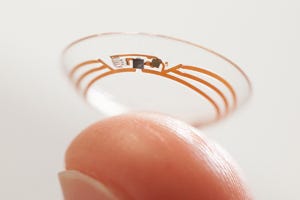Google Focuses on Diabetes Care
Google has announced its plans to develop a contact lens that could help diabetics keep track of their blood glucose levels. Spearheaded by Babak Parviz of Google Glass fame, the project could reduce or perhaps even eliminate the need for diabetics to prick their finger to manage their diabetes.
"At Google[x], we wondered if miniaturized electronics--think: chips and sensors so small they look like bits of glitter, and an antenna thinner than a human hair--might be a way to crack the mystery of tear glucose and measure it with greater accuracy," Parviz and project co-founder Brian Otis said in a Google blog post. 
The prototype developed by the company sandwiches a small wireless chip and glucose sensor between two layers of soft contact lens material. Prototypes are able to take readings once per second, according to Parviz and Otis, who also worked together for years as University of Washington researchers.
Thursday's news clears up some questions about a Google team's recent visit to the FDA. (Contact lenses are a Class II medical device.) Parviz and Otis say there's much more work to do in order to transform the technology into something people might actually use.
"We're not going to do this alone: we plan to look for partners who are experts in bringing products like this to market. These partners will use our technology for a smart contact lens and develop apps that would make the measurements available to the wearer and their doctor," Parviz and Otis said.
Check out the conference track on inspiring design, prototype, and usability from February 10 through 13 at MD&M West in Anaheim, CA. |
The two were short on details when it came to where information might be downloaded to, but they also said they are exploring integrating tiny LEDs that would light up if glucose levels are above or below a certain level.
Re/code recounts a September 2009 piece for IEEE Spectrum in which Parviz said a contact lens display would likely need a separate, portable device to relay displayable information to the len's control circuit, operating the optoelectronics in the lens.
Irish health technology innovator Michael O'Shea made a guess about the Google lens' communication during a Digital Health group discussion on LinkedIn. O'Shea thought it could be an RFID system, a "passive system that simply replies with the sensor value when activated by an external communicator."
Michael Kremliovsky, a a software systems expert at Hospira, noted on Digital Health that it is important to measure glucose levels during sleep, but sleeping with contact lenses on has not been advisable in the past.
Researchers have been exploring retooling contact lenses for a while. They've investigated their use, for instance, to deliver drugs to the eye.
Parviz's work on contact lenses is not new. The MIT Technology Review profiled Parviz's work on electronics-embedded contact lenses in 2008. Microsoft in 2011 touted work with Parviz on a glucose-monitoring lens. But the Google announcement presents a higher level of seriousness because the discussions are underway with the FDA.
Parviz and research colleagues argued in a January 2012 paper in the IEEE Journal of Solid-State Physics that the on-lens electrochemical sensor they've been working with provides real-time continuous glucose monitoring and high sensitivity compared with conventional glucose monitoring.
Parviz has also sought to bring display technology to contact lenses.
Contact lens display technology was already on display at the recent International CES, where Bellevue, WA-based Innovega showed off its iOptik platform that combines a contract lens paired with a glass-pointed projector.
Other advances include telescopic contact lenses, which NewScientist reports are being developed by researchers in Switzerland and California.
Is there some advance in actual contact lens technology, such as the materials contact lenses are made of, that is causing all of this innovation? Or is this really about miniaturization -- the ability, say, to embed tiny electronics in an a platform such as a contact lens that itself hasn't changed much over the years?
O'Shea in the Digital Health discussion thinks this is about the convergence of multiple technologies including miniaturized electronics, perhaps advances in lens materials, nanotechnology, and advances in wireless communications. "So now the platform is in place (or thereabouts), just add in a need (diabetes) and good funding (Google) and the products roll out," O'Shea says.
Managing diabetes has long been difficult because of the need to prick oneself with a needle in order to conduct a blood glucose test--not something that many people enjoy doing. Researchers have looked into tests involving breath, saliva, tears, and urine--as well as microneedle blood tests that would cause less discomfort.
Chris Newmarker is senior editor of MPMN and Qmed. Follow him on Twitter at @newmarker. Brian Buntz is the editor-in-chief of MPMN and Qmed. Follow him on Twitter at @brian_buntz.
About the Author(s)
You May Also Like

.png?width=300&auto=webp&quality=80&disable=upscale)
